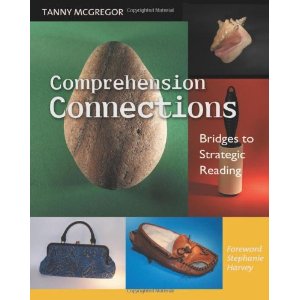 I recently got my hands on Tanny McGregor’s Comprehension Connections, Bridges to Strategic Reading after a friend recommended it to me. I have nothing but great things to say about this resource. The book gives unique lesson starter ideas using tangible objects for each of the following comprehension strategies: Metacognition, Visualizing, Inferring, Questioning, Determining Importance, and Synthesizing. The ideas mentioned help to make abstract ideas concrete. As I read it, I felt the ideas were most appropriate for 2nd through 4th but could most likely be applied to the upper or lower grades. Here is a brief outline of the ideas I found most useful:
I recently got my hands on Tanny McGregor’s Comprehension Connections, Bridges to Strategic Reading after a friend recommended it to me. I have nothing but great things to say about this resource. The book gives unique lesson starter ideas using tangible objects for each of the following comprehension strategies: Metacognition, Visualizing, Inferring, Questioning, Determining Importance, and Synthesizing. The ideas mentioned help to make abstract ideas concrete. As I read it, I felt the ideas were most appropriate for 2nd through 4th but could most likely be applied to the upper or lower grades. Here is a brief outline of the ideas I found most useful:
*Note: I have recreated the “Thinking Stems” lists as posters for each of the comprehension strategies. They are free to download here.
Metacognition:
-The Reading Salad- 3 bowls: 1 large (labeled: salad), 1 small (labeled: text), 1 small (labeled: thinking). As the teacher reads, volunteer students place colored pieces of salad in to the appropriate bowl (green paper for thinking, red for text). Teacher models her thinking while she reads an unfamiliar text. The resulting ‘salad’ should have more ‘lettuce’, in the bowl by the end.
-Oversized thought bubble
-Paint chip cards determining “crystal clear”, “a bit hazy”, “I’m in a fog”. Point while reading silently
-Thinking Stems: I’m thinking, I’m noticing, I’m wondering, I’m seeing, I’m feeling
- Using schema: Thoughtful readers make connections, and retrieve and activate prior knowledge.
-Sticky Lint Roller: Use to roll over and pick up pieces of paper with thoughts, memories ideas that make you, you. Our brain is the lint roller. It is ready to stick to whatever it comes in contact with.
-T-Chart: one side something very familiar, i.e. “Disney”, on the other, an obscure place i.e. “Immokalee”. Class helps to list out everything that reminds them of Disney (this is easy for most of class). Do the same for Immokalee. Most kids may not be able to contribute. Teacher models that she has schema for Immokalee from visiting parents in small Florida town.
-Thinking Stems: That reminds me of, I’m remembering, I have a connection to, I have schema for, I can relate to
- Inferring: Thoughtful readers draw conclusions, make predictions, and form interpretations.
-Bag of “garbage” from pretend mystery neighbor’s house. Determine with class what they can learn about family from their garbage.
-Mystery object game
-Cut out main object from magazine ads. Have kids determine what must be the object or service being sold based on ad clues.
-Thinking stems: My guess is, Maybe, Perhaps, It could be that, This could mean, I predict, I infer
- Questioning: Thoughtful readers generate questions before, during, and after reading.
-Very special object: bring in object, i.e. rock. Do not tell kids much more than that this object is very special to you. List as many questions as the class can generate about the object while passing around the circle. Each day share a bit more about your rock story prompting more (and deeper) questions from class.
-“We’re in the business of questioning; we’re open 24/7!”
-Q Food
-Use wordless books to prompt questioning. Try David Wiesner: FreeFall, Tuesday, Sector 7.
-Thinking stems: I wonder, what if, why, I don’t understand, It confused me, How Could
- Determining importance: Thoughtful readers sift our relevant and useful information.
-Display purse and empty (carefully planned) contents. Tell students you will be heading to track to walk for exercise and don’t want to take whole purse; just the necessary objects inside. students turn and talk. List their thinking as they determine importance.
-Wordless book: Circle of Friends, Giora Carmi
-Thinking stems: What’s important here, what matters to me, one thing that we should notice, I want to remember, it’s interesting that
- Visualizing: Thoughtful readers create mental images supported by the five senses.
-Cardboard paper towel tubes: “Viewfinder”. When we use a viewfinder, objects become clearer, colors more vivid. Use to introduce visualization.
-Soak cotton balls in different liquids (orange juice, mouth wash, salad dressing, sun tan lotion) and seal each in different ziploc bag. Have kids describe visualizations that the smells bring about.
-Mental images through images. Students write or draw while listening to unique music.
-Thinking stems: I’m picturing, I can imagine, I can feel/smell/see/taste/touch/hear
- Synthesizing: Thoughtful readers continually change their thinking to response to text.
-Nesting dolls. How can they represent our thinking?
-Write book response in shape of a spiral growing bigger and bigger.
-Thinking stems: Now I understand why, I’m changing my mind about, I used to think___ but now I think, my new thinking is, I’m beginning to think
I have recreated the “Thinking Stems” lists as posters for each of the comprehension strategies. They are free to download here.


Leave a comment